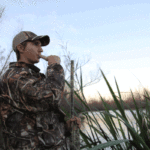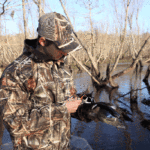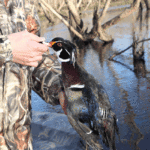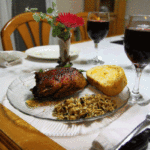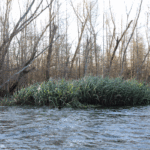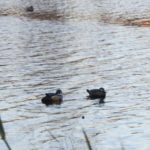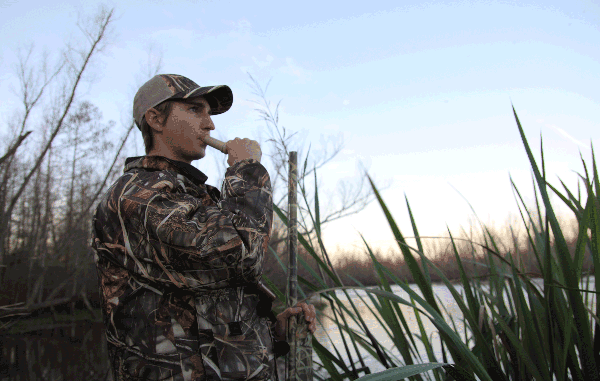
This Eagle Scout provides tips on how to take more Atchafalaya Basin wood ducks.
Long before daylight, Cole Romero laid flat on his back along the floor of the boat, the back of his head resting on a gear bag positioned on the front deck like a pillow.
Comfortably out of the wind with his friend Michael Broussard at the helm, Romero was content to watch the stars that suddenly looked like you could touch them as we left the city lights of Berwick Bay heading upriver into the Atchafalaya Basin to hunt wood ducks.
The Boy Scout Oath reads: “On my honor, I will do my best, to do my duty to God and my country. To help other people at all times, to obey the scout law, and to keep myself physically strong, mentally awake and morally straight.”
Broussard, now 20 years old, became an Eagle Scout in 2010. And, it didn’t take long to see how the Scout oath impacted everything about our hunt, from the way Broussard handed out personal floatation devices to strapping the kill-switch lanyard of his Mud Buddy around his wrist. Not to mention the tactics he uses to be successful at whatever his endeavor, whatever his challenge.
Take this past summer, for example. Broussard’s idea of a vacation was hiking 130 miles across the New Mexico landscape.
And, on the local level, hunting wood ducks in the Atchafalaya Basin is another example of the type of challenge Broussard is willing to take on. What’s more, share with others like his friend Romero.
Romero, several years older than Broussard, had never hunted wood ducks before — for that matter, never hunted period prior to the 2011 season. In keeping with the “helping others” part of the Scout Oath, Broussard was more than willing to introduce his friend to the sport.
“I got into duck hunting when my dad put a shotgun in my hand when I was 6 or 7 years old,” Broussard recalled, talking like someone well beyond his years. “Some kids are brought up in a boat, like I was, some aren’t. Some aren’t fortunate enough to have parents who fish and hunt. I did.
“But anytime I can take somebody hunting or fishing, I’d rather it be someone who has never done it before. You don’t get the same satisfaction as you do when showing someone what it’s all about the first time.”
The Basin is full of wood ducks, but they’re skittish, early morning — near twilight fliers — and they hear and see extremely well. Tactically, Broussard makes it a point to scout and observe woodies prior to his hunts.
“You’ve got to study the birds,” he said. “I mean, that’s the only way you’re going to be successful. The birds aren’t dumb. Wood ducks have always been in the Basin. And in the little holes that my dad and his friends showed me while I was growing up there’s always been birds.
“But when you look for wood duck holes, there’s always going to be a pond inside of a pond surrounded by trees. That’s the only way to describe it. You’ve got all these little islands all over in the Basin, and those little ponds are inside of the trees surrounded by water on the outside. The wood ducks just like flying those tree lines and go into the ponds inside.”
Early mornings and late afternoons are the best times to observe wood duck flight patterns. Quite often when targeting woodies, the whole morning shoot literally can be over before the sun breaks the horizon.
Paying close attention to wood duck flight paths during late summer morning and afternoon fishing trips in the Basin can provide you with a good idea of where to set up come fall.
Fortunately, wood ducks during those morning and afternoon flights tend to fly the same pipelines, bayous, or lake-side tree lines day after day and year after year.
“For the most part we’ll see those birds flying the tree lines, and we’ll go check out where they’re going,” Broussard said. “Once we know where they’re going, then we determine if the area is available for us to get to by boat or by foot.
“Once I know the pond they’re going into and how I can get into it, then I see if I want to make a fixed or mobile blind.”
He said the closer to the ground you are the better the chances you have of not spooking skittish wood ducks. But, in getting close to the ground, hunters also will need to determine whether to use a blind built from natural cover or a popup type.
Broussard, however, tends to stay away from the popups.
“The closer you get to the ground the better,” Broussard explained. “And, the better you blend in with the natural environment the better.
“So many people use popup blinds up north, and by the time they get here they’re used to seeing it and flare when coming into a hole. But, to sum it up you should use natural material to breakup the outline of your blind, whether it’s a popup around your boat or ground blind.”
Broussard is also a self-taught wood duck caller. On his own, with the help of Internet technology and a few videos, he perfected his skills and that tactically improves his success when hunting this particular species.
“In the dark — the predawn — I’ll call to get their attention,” Broussard said. “I learned right away that I sounded like what they were looking for. I discovered there is a different call for when wood ducks are flying and a sit-down call with a squeal at the end that says, ‘ I’m sitting right here.’
“Pretty much, once I got that cadence of ‘I’m flying — now I’m sitting’ down, wood ducks started responding. I found out in the predawn darkness just because you can’t see them doesn’t mean they can’t hear you.”
On our hunt, Broussard — with only stars in the sky before legal shooting light — made a few calls. And, interestingly enough had birds flying, one of which lighted in our decoy spread. Making a believer out of me, someone who doesn’t use a wood duck call, it was remarkable to see how the early birds became interested and able to locate our grassy hide within the Basin with practically the precision accuracy of a GPS.
Broussard understands the same wariness that wood ducks portray when it comes to blinds, also extends to decoy spreads and how lifelike decoys look. Because duck hunting in the Basin isn’t only a wood duck affair (gadwalls, blue-winged teal and mallards also can be harvested at times), he uses a mixture of decoys.
But, how he uses them tactically, paying close attention to the little details to reduce some of a woody’s shyness, is what helps him find success.
“Positioning wood duck decoys in a spread is important,” Broussard said. “If I’m targeting other ducks in an area of the Basin where I hunt woodies, I’ll put my wood duck decoys to the outside, where they stand out.
“You don’t want them in the middle of a spread of grays or mallards. Instead, you want them on the outside and in pairs.
“I also make sure all of my decoys are clean, but especially wood ducks. I’ll use WD-40 on them to get that shine.”
One thing hunters who go into the Atchafalaya Basin will find is quiet solitude. The slightest clanking noise from something dropped in a boat echoes in the cypress and tupelo swamps where woodies roost and feed, startling them.
And Broussard tat can work against success if hunters aren’t careful to keep quiet.
“They are a very skittish bird,” Broussard said. “Just snapping a button on your coat they’ll go from sitting right in front of you to, ‘I’m out of here!’ In just observing this behavior, I’ve seen where they’ve been committed and heading toward the blind and the noise from calls clanking together caused them to flare. I’ve had them light in the decoys and a clank spooked them.
“So they can pick up just about any sound from the clanking of your calls on your lanyard to the sound of your jacket rubbing the brush that conceals you and the closing of metal gun boxes in the boat. All of those kinds of sounds and noise will cause them to shy away.”
Pulling into his natural grass blind at 5 in the morning, I was glad part of the Scout’s Oath that Broussard took was to keep mentally awake because we were pretty early — another part of his scout-like preparation. And, because much of the Basin is public land, the young duck hunter didn’t want to lose his grassy spot in the pond we’d be hunting.
Only seconds after legal shooting light we missed our first chances at birds that flew over the blind when Romero and I weren’t as mentally awake as Broussard.
It might have had something to do with the cup of hot coffee I had in my hand, but Romero was without excuse. We later made up for our early faux pas, knocking down a couple birds that passed over our blind.
The Scout’s Slogan says to “do a good turn daily.” No doubt, my young Eagle Scout friend did a good turn for Romero and myself in the Atchafalaya Basin on our wood duck hunt.
And, that’ll be Scout’s honor…
